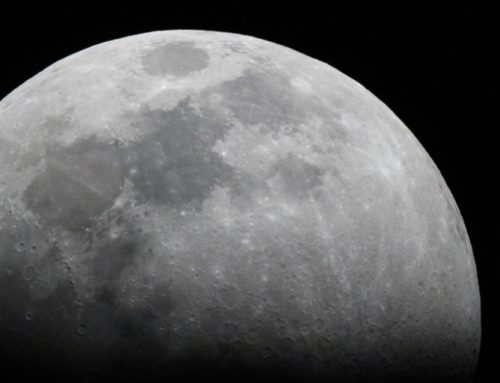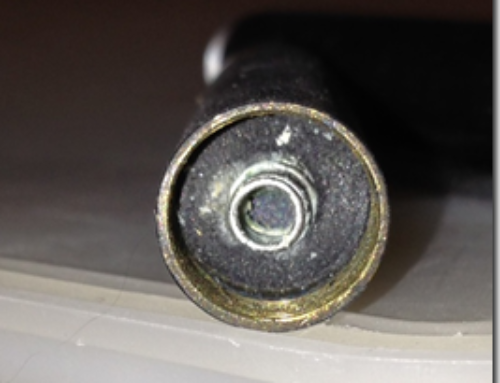The earth rotates, sweeping the star field across the sky. If we take a long exposure of the stars, with the camera stationary, the stars will appear as star trails in the image. We can estimate the length of the trail on our image. This is a useful number if we want to accentuate the trails or adjust the exposure time to minimize the star trails.
The earth rotates at the rate of 360 deg in 24 hours, which is w = 360 deg/24hours x 3600 arc-sec/deg = 15 arc-sec/sec. A star that is on the celestial equator, a declination of 0 deg, will sweep across the sky at this angular rate.
The closer to the celestial north pole, the shorter its arc. The arc across the sky is related to the sine (declination). The worst case will be for stars near the equator. Even 45 degrees off from the equator, the angular speed will still be within 70% of this value. Using the maximum angular speed is a good upper bound estimate for the size of a star trail.
The angular field of view of a single pixel, the minimum resolving power of a pixel, theta, is related to the ratio of the pixel size, d, and the focal length, fl: theta = d /fl.
This angle is in radians. To convert radians into arc-sec, we need to multiple the radians by 206264, the number of arc-sec in a radian.
Theta (arc-sec) = theta (rad) x 206,264 = d/fl x 206264.
If we use units of microns for the pixel size and mm for the focal length, then, Theta (arc-sec) = 206 x d/fl: d in microns, fl in mm.
The speed at which a star travels over the surface of the sensor, in pixels per second is, Speed = w/theta in pixels/sec.
For a given exposure time, we can easily estimate the size of a star trail in pixels as
N = speed x time = w/theta x time = w/(206 x d) x fl x time
For my cannon xsi and widest field lens with 18 mm focal length, we have:
d = pixel size in microns = 5.2 microns
w = angular speed of the earth = 15 arc-sec/sec
fl = the lens system focal length in mm = 18 mm
time = exposure time in sec
For my Canon, using the 18 mm lens, the angular resolution is
Theta (arc-sec) = 206 x d/fl: = 206 x 5.2/18 = 60 arc-sec = 1 arc-min
And, the length of a star trail, in pixels is:
N = 15 arc-sec/sec /60 arc-sec/pixel x time = 0.25 pixels/sec x time.
This is the track size we expect, as worst case, for a star near a declination of 0. If the exposure time is 30 sec, the track length will be 7.5 pixels.
Here is the image from a 30 sec exposure of the sky in my backyard.
The track length is on a diagonal of a square with each side being about 6 pixels long. This is a diagonal of about 8.4 pixels. It is blurred out a little, probably from lack of a great focus, but our estimate is very close to what we measure.
When we shoot in raw, we get the data from each pixel. When we use the lowest shooting resolution for the Canon, the number of pixels we end up with goes from 4272 x 2848, or 12.17 Mpixels to an image size of 2256 x 1504, or 3.39 Mpixels. This is about a 4x reduction in pixels, or about a 2x increase in the lateral size of a pixel.
When shooting the lowest resolution for the Canon xsi, when the effective pixel size doubles in lateral dimension, we expect the track size to be cut in half, to half the number of pixels.
Instead of a track size of 7.5 pixels in 30 sec, we expect about 4 pixels in for a 30 sec exposure.
Here is an example. It is about 4 pixels in length.
Summary
As a rough rule of thumb, the pixel resolution of the canon xsi is about 1 arc-min per pixel at the full resolution, and widest field of view of 18 mm.
The earth rotates at 15 arc-sec/sec or about ¼ arc-min per second.
To limit a star trail to be 1 pixel, we need to have an exposure shorter than 4 sec.
If we take images, and then reduce the pixel count by averaging or combining adjacent pixels, the star trail track size will be reduced by the number of linear pixels that are turned into 1 pixel.
For example, if we shoot in raw, and convert this to a VGA resolution of 640 x 480, we convert 4272 pixels across into 640. This is a factor of 6.7.
Coincidently, if we are going to end up with a VGA formatted image of a moving sky, we can shoot for 30 seconds, and the resulting star trails will be 1 pixel, hardly noticeable.







